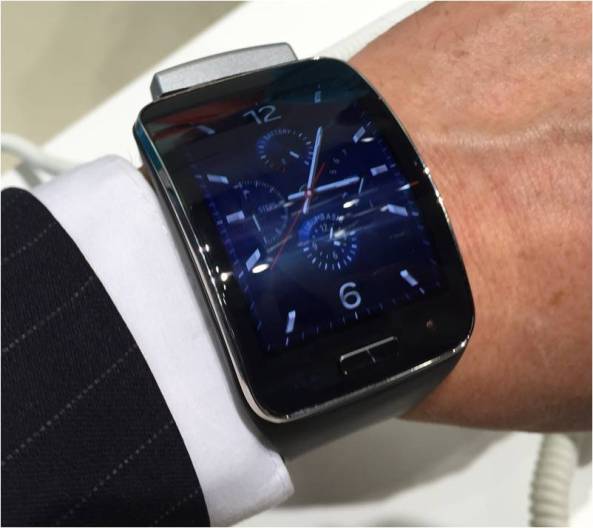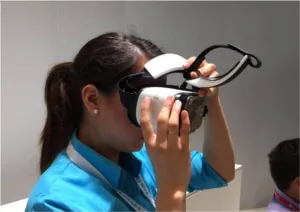Samsung VR
Samsung’s VR device will take the S6 and S6 Edge (Samsung Unpacks Two New Phones) as the display source. The carrier headset provides a snug fit for the smartphone, so a new Samsung smartphone with different dimensions may not fit. Even though there are slight differences in the dimensions between the S6 and the S6 Edge, both will fit into the Samsung VR headset. To test the device, the company made everyone sit down, which seemed odd at first but became very obvious once you put on the headset. As a VR device, it blocks the outside world completely and since the content extends around the viewer, one can get disoriented quickly. None of the running examples included visual feedback of the surroundings through the device camera.
The demo included different content types, videos (a circus act and a wildlife video) as well as a first person shooting game. The videos provide a very intimate and compelling presentation. It pulls the viewer into the action in a way no other medium can. While the VR provides an unrivaled immersion into any type of content, the weakest link so far is the optical performance. The game worked better for me, but in both instances the resulting resolution per eye was somewhat disappointing. The VR experience is based on stereoscopic 3D images. Since there is no crosstalk, this works very well, even though the 3D effect was very strong. The interesting part was the ability to look around the location as the content also included people sitting next to the viewer. This is a very interesting concept that may work very well in sports or virtual meetings, in other words it might provide the optimal video conferences. This is also an interesting concept for the game, where you can be attacked not only from the front but also from the side and back as well; it is up to you to look over your shoulder, so to speak. Aiming required just looking at the opponent, a feature that worked much better than I had expected. This may not be the most accurate way of aiming as it involves more neck/eye coordination than hand/eye coordination.
Analyst Comment
The images appeared grainy and pixelated, not what one would expect from a high resolution display as used in the newest Samsung Galaxy smartphones. The resulting resolution to the eye is somewhat disappointing as there is a strong pixelation visible in all viewed content. As a matter of fact it looks like an LED wall when you walk too close or like a 42″ FHD LCD TV watched from a distance of three inches. Looking carefully at a specific point lets you see the subpixel structure and the relevant subpixel intensities for each pixel. This is something that I would have not expected from a 2560 x 1440 display like the ones in the S6 and the S6 Edge. There is also the effect that to the sides of the image, the edges of the content show some color effect that increases towards the edge of the screen. This effect is also visible if the user moves their head quickly in either direction. It is difficult to say if this comes from the optical elements (chromatic aberration) or the display itself, but both factors may contribute to this effect.
Samsung Galaxy Gear S
The Samsung smartwatch on display was the Galaxy Gear S. Announced late in 2014, the device is not new but was still the latest announcement of Samsung in this field. It is also one of the largest smartwatches available in the market today with its 2″ (360 x 480) Super AMOLED display. One of the key features is the use of the Tizen operating system over Android Wear as used by most other vendors.

The Gear S is an example of the smartphone on your wrist type device that can look overwhelming on a small wrist. The image below shows the issue with wearing such a device. While the details are well executed from a design standpoint, the overall impression is that of a technical gadget first and not that of a wristwatch. The curved SAMOLED display looks great, and makes the large watch more palatable for the consumer.

